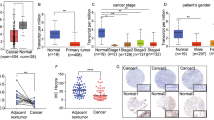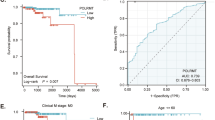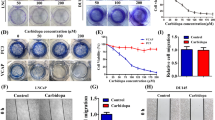Abstract
Ornithine decarboxylase (ODC), the first enzyme of polyamine biosynthesis, was found to increase in cancer cells, especially prostate cancers. Some chemotherapeutic agents aimed to decrease ODC expression showed inhibitory effects on cancer cells. In this study, we examined the effect of adenoviral-transduced antisense ODC on prostate cancer cells. An adenovirus carrying antisense ODC (rAd-ODC/Ex3as) was infected to prostate cancer cells PC-3 and LNCap. Expression of ODC and concentration of polyamines in cells were determined by Western blotting and HPLC. MTT (3-(4,5-methylthiazol-2-yl)-2,5-diphenyl-tetrazolium bromide) assay was used to analyze the effect on cell growth. Cell cycle was evaluated by FCM and cellular invasion by Matrigel invasion assay. A nude mouse xenograft model was used to examine tumorigenicity. Expression of ODC in PC-3 and LNCap cells were reduced to 45 and 59%, and three polyamines were also decreased by the rAd-ODC/Ex3as treatment. Consequently, cell growth was substantially inhibited and cell cycle arrested at G1 phase. Matrigel invasion assay showed relatively low invasion. Marked suppression of tumor formation was observed in the xenograft model. This study suggests that rAd-ODC/Ex3as has the antitumor effect on the human prostate cancer cells.
This is a preview of subscription content, access via your institution
Access options
Subscribe to this journal
Receive 4 print issues and online access
$259.00 per year
only $64.75 per issue
Buy this article
- Purchase on Springer Link
- Instant access to full article PDF
Prices may be subject to local taxes which are calculated during checkout





Similar content being viewed by others
References
Auvinen M, Paasinen A, Andersson LC, Holtta E . Ornithine decarboxylase activity is critical for cell transformation. Nature 1992; 360: 355–358.
Moshier JA, Dosescu J, Skunca M, Luk GD . Transformation of NIH/3T3 cells by ornithine decarboxylase overexpression. Cancer Res 1993; 53: 2618–2622.
Pegg AE, Xiong H, Feith DJ, Shantz LM . S-adenosylmethionine decarboxylase: structure, function and regulation by polyamines. Biochem Soc Trans 1998; 26: 580–586.
Marton LJ, Pegg AE . Polyamines as targets for therapeutic intervention. Annu Rev Pharmacol Toxicol 1995; 35: 55–91.
Moshier JA et al. Isolation and expression of a human ornithine decarboxylase gene. J Biol Chem 1990; 265: 4884–4892.
Pegg AE, Madhubala R, Kameji T, Bergeron RJ . Control of ornithine decarboxylase activity in alpha-difluoromethylornithine-resistant L1210 cells by polyamines and synthetic analogues. J Biol Chem 1988; 263: 11008–11014.
Sistonen L et al. Activation of the neu tyrosine kinase induces the fos/jun transcription factor complex, the glucose transporter and ornithine decarboxylase. J Cell Biol 1989; 109: 1911–1919.
Auvinen M, Paasinen A, Andersson LC, Holtta E . Ornithine decarboxylase activity is critical for cell transformation. Nature 1992; 360: 355–358.
Devens BH et al. Polyamine depletion therapy in prostate cancer. Prostate Cancer Prostatic Dis 2000; 3: 275–279.
Glikman P et al. Ornithine decarboxylase activity, prolactin blood levels, and estradiol and progesterone receptors in human breast cancer. Cancer 1987; 60: 2237–2243.
Upp Jr JR et al. Polyamine levels and gastrin receptors in colon cancers. Ann Surg 1988; 207: 662–669.
Love RR, Astrow SH, Cheeks AM, Havighurst TC . Ornithine decarboxylase (ODC) as a prognostic factor in operable breast cancer. Breast Cancer Res Treat 2003; 79: 329–334.
Umemoto S . Antitumor effect of alpha-difluoromethylornithine (DFMO) changes in ornithine decarboxylase (ODC) activity and polyamine (PA) levels in human tumor transplanted into nude mice. Nippon Geka Gakkai Zasshi 1989; 90: 650–660.
Zagaja GP et al. Effects of polyamine analogues on prostatic adenocarcinoma cells in vitro and in vivo. Cancer Chemother Pharmacol 1998; 41: 505–512.
Guan J, Fan M, Cao S . Reversion of malignant phenotypes of human lung squamous carcinoma cells by ornithine decarboxylase antisense RNA. Zhonghua Zhong Liu Za Zhi 1996; 18: 81–83.
Liu X et al. Ornithine decarboxylase activity and its gene expression are increased in benign hyperplastic prostate. Prostate 2000; 43: 83–87.
Meager A . Gene Therapy Technologies, Applications and Regulations. John Wiley & Sons: New York, 1999, 81pp.
Zhang Y et al. Construction of an antisense RNA recombinant adenovirus vector of the third extron in ODC gene. J Shandong Univ (Health Sci) 2003; 41: 371–374.
Prevec L et al. Immune response to HIV-1 gag antigens induced by recombinant adenovirus vectors in mice and rhesus macaque monkeys. J Acquir Immune Defic Syndr 1991; 4: 568–576.
Wei D, Tang Z, Chen S . Construction of recombinant adenovirus vector containing mIL-12 using the method of homogenous recombination in bacteria and its expression in vitro with high efficient. Chin J Biochem Mol Biol 2000; 16: 716–721.
Fu S, Zou X, Wang X, Liu X . Determination of polyamines in human prostate by high-performance liquid chromatography with fluorescence detection. J Chromatogr B 1998; 709: 297–300.
Rockwell SC, Kallman RF, Fajardo LF . Characteristics of a serially transplanted mouse mammary tumor and its tissue-culture-adapted derivative. J Natl Cancer Inst 1972; 49: 735–749.
Auvinen M et al. Human ornithine decarboxylase-overproducing NIH3T3 cells induce rapidly growing, highly vascularized tumors in nude mice. Cancer Res 1997; 57: 3016–3025.
Metcalf B et al. Catalytic irreversible inhibition of mammalian ornithine decarboxylase by substrate and product analogues. J Am Chem Soc 1978; 100: 2551–2553.
Schipper RG et al. Antitumor activity of the polyamine analog N(1), N(11)-diethylnorspermine against human prostate carcinoma cells. Prostate 2000; 44: 313–321.
Bello-Fernandez C, Packham G, Cleveland JL . The ornithine decarboxylase gene is a transcriptional target of c-Myc. Proc Natl Acad Sci USA 1993; 90: 7804–7808.
Madhubala R, Pegg AE . Inhibition of ornithine decarboxylase and S-adenosylmethionine decarboxylase synthesis by antisense oligodeoxynucleotides. Mol Cell Biochem 1992; 118: 191–195.
Mi Z et al. Human prostatic carcinoma cell lines display altered regulation of polyamine transport in response to polyamine analogs and inhibitors. Prostate 1998; 34: 51–60.
Ko SC et al. Molecular therapy with recombinant p53 adenovirus in an androgen-independent, metastatic human prostate cancer model. Hum Gene Ther 1996; 7: 1683–1691.
Thomas T, Kiang DT . Additive growth-inhibitory effects of DL-alpha-difluoromethylornithine and antiestrogens on MCF-7 breast cancer cell line. Biochem Biophys Res Commun 1987; 148: 1338–1345.
Alm K et al. Treatment of cells with the polyamine analog N, N11-diethylnorspermine retards S phase progression within one cell cycle. Eur J Biochem 2000; 267: 4157–4164.
da Rocha AB et al. Protein kinase C-mediated in vitro invasion of human glioma cells through extracellular-signal-regulated kinase and ornithine decarboxylase. Pathobiology 2000; 68: 113–123.
Manni A et al. Influence of polyamines on in vitro and in vivo features of aggressive and metastatic behavior by human breast cancer cells. Clin Exp Metastasis 2002; 19: 95–105.
Acknowledgements
We gratefully acknowledge the generosity of Dr Bert Vogelstein for providing the pAdeasy-1 adenovirus system. This work was supported by Foundation of Department of Science and Technology of Shandong Province 2001CA1CAA3 and Foundation of Department of Sanitation of Shandong Province.
Author information
Authors and Affiliations
Corresponding author
Rights and permissions
About this article
Cite this article
Zhang, Y., Liu, X., Zhang, B. et al. Antitumor effect of antisense ODC adenovirus on human prostate cancer cells. Prostate Cancer Prostatic Dis 8, 280–286 (2005). https://doi.org/10.1038/sj.pcan.4500808
Received:
Accepted:
Published:
Issue Date:
DOI: https://doi.org/10.1038/sj.pcan.4500808
Keywords
This article is cited by
-
Downregulation of ornithine decarboxylase by pcDNA-ODCr inhibits gastric cancer cell growth in vitro
Molecular Biology Reports (2011)
-
Targeted antitumor effect induced by hTERT promoter mediated ODC antisense adenovirus
Molecular Biology Reports (2010)



